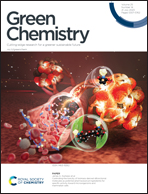The environmental impact and economic feasibility assessment of composite calcium alginate bioplastics derived from Sargassum†
Abstract
For much of the Caribbean region, plastic pollution and the persistence of the great Atlantic Sargassum belt lead to significant regional loss in biodiversity, employment and tourism. Yet, seaweeds such as Sargassum possess all the characteristics for bioplastic production. This study presents a new process on the production of biodegradable calcium alginate (Ca(Alg)2) composite bioplastic, and evaluates its economic feasibility and environmental impact in the Caribbean, compared to bio-based polylactic acid (PLA) and synthetic plastics (PET). Our cradle-to-gate life cycle impact assessment (LCIA) shows normalized (kg CO2eq per kg plastic) greenhouse gas (GHG) impacts 3 to 7 times higher for the baseline alginate composite process over those of PLA and PET films – linked mainly to chemical consumption. However, through the integration of abundant bioenergy from the local paper industry and the nascent E-methanol (E-MeOH) supply chains, GHG impact reduces by 79% – illustrating a pathway to a sustainable bioplastic production flowsheet. More attractively, the alginate bioplastic outperforms in providing ultra-low oxygen barrier packaging properties – with a required mass of plastic material producing a total carbon footprint (kg CO2eq) 64–978 times lower than PLA and PET respectively, and overall packaging costs 280 times less than current synthetic plastic. Techno-economics illustrate that a total annualized cost (TAC) for alginate bioplastic of $US 4.56 per kg is possible, ensuring high economic feasibility, comparable to current commercial bio-based alternatives. Moreover, sensitivity analysis highlights that variability in TAC was mainly associated with sodium alginate utilization in the manufacture process – contributing up to 67% to the overall cost. In light of this, the integration of sound policies aligned to improved consumer awareness and reduced plastic waste can help to drive greater economic feasibility of the alginate bioplastic industry. Ultimately, our study illustrates a viable and sustainable alginate bioplastic alternative, promoting and informing on packaging innovation while achieving low carbon operations within the Caribbean plastic sector.



 Please wait while we load your content...
Please wait while we load your content...